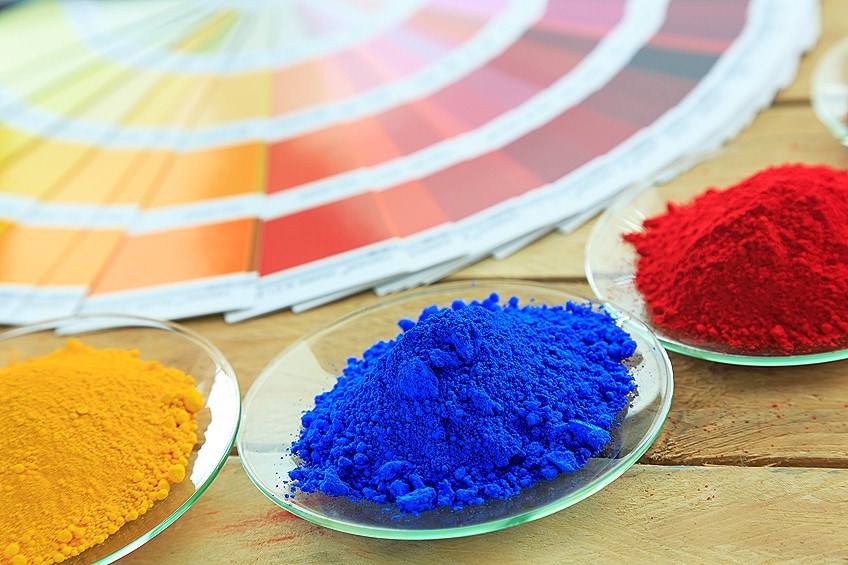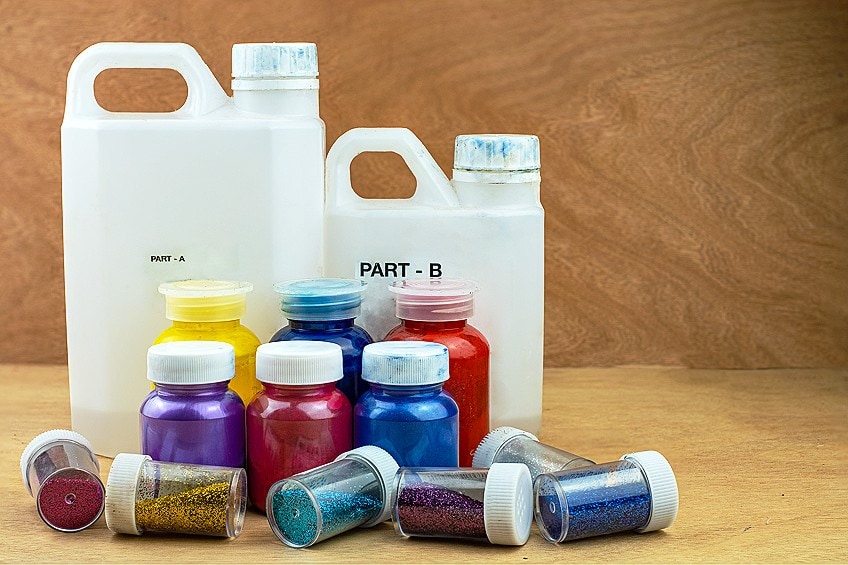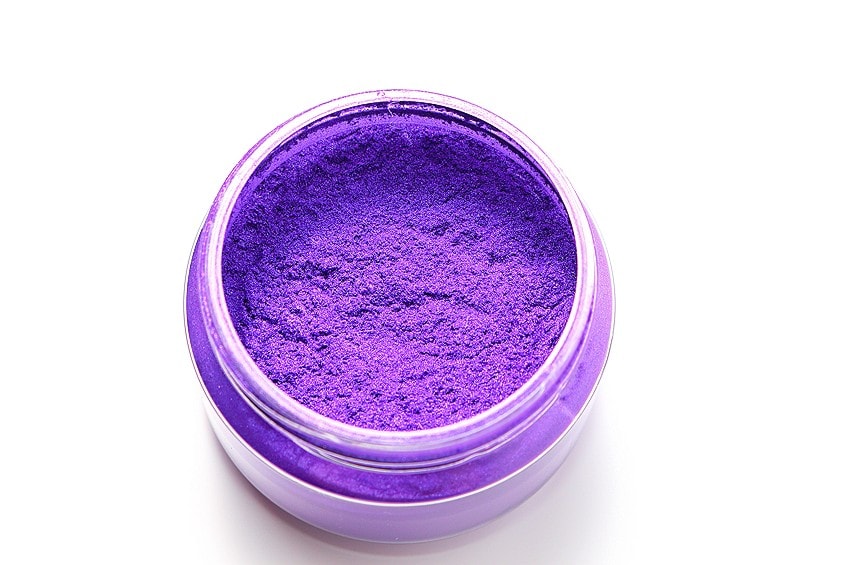Mica Powder – Using Mica and Pigment Powder in Epoxy Resin
This post may contain affiliate links. We may earn a commission from purchases made through them, at no additional cost to you.
Mica powder is a mineral that is safe to use and can be found in such things as soaps, body lotions, and other cosmetic products. Mica powder can even be found in certain art materials. The powder gives a shimmery, metallic effect. Another similar product to mica powder is that of pigment powder, the only difference being the shine. While the mica powder shimmers, the pigment powder gives a matte appearance. You can use the mica powder on or in many things and it will always provide a captivating shine. Let us have a closer look at both mica and pigment powder.
What is Mica Powder?
Mica powder is a natural mineral that can be ground and produces a pearl-like metallic shimmer effect. You can think of mica powder as a type of glitter material that sparkles. You can get a variety of colors, but the main function of the powder is to give the sparkly, shimmer and shine. This type of powder will not produce vivid or solid colors.

The knowledge of mica powders can be traced far back into history and was used amongst the Romans, Greeks, Indians, Egyptians, Aztec, and Chinese civilizations. Some cave paintings that contain mica powders have even been discovered that date back to the Upper Paleolithic era.
Mica is properly referred to as a mica powder and not as a pigment, although you might read in many places about mica pigment. We will be dealing with pigment powders further in the article.
Pros
- The single best advantage is its natural shine and shimmer effect, as it can be ground to a powder that is exceptionally fine.
- The powder is natural and non-toxic, which means you can use it on your skin without any harmful side-effects. This is why it is well-liked among those who would rather use natural cosmetics.
Cons
- The majority of mica is mined in India and, in many cases, the mining is performed by using child labor due to the huge amount of poverty in the country.
- You will not get a deep or solid color.
The Best Mica Powder for Epoxy Resin: JACQUARD Pearl Ex Pigments
Jacquard’s mica powders are the best multipurpose products because they create amazing colors in epoxy resin and are non-toxic. Looking for a metallic effect? The Pearl Ex series is perfect, as it provides a beautiful effect and will not fade or become discolored.
- Non-toxic metallic mica powder
- Rust- and tarnish-proof pigments
- Colorfast and stable
This product includes an assortment of six metallic mica pigments, including Pearlwhite, Antique Silver, Super Copper, Interference Blue, Due-Violet Brass, and Sparkle Gold.
Pros
- This product is non-toxic.
- A little bit goes a long way.
- It produces a sparkling, metallic effect.
- There is a beautiful range of colors.
- The pigments are colorfast and rust-proof.
Cons
- The powders can be messy to work with.
Creating Art Projects with Mica Powders
You can use clear mica powders in your artworks to provide a shimmer-and-sparkle effect. If you do use them with more opaque colors, the powder will become hidden as it is ground so finely.
You can combine colors to create more of an even metallic sheen, or to use for a more subtle effect. Artists who use the painting medium known as egg tempera for iconography will find it exceptionally worthwhile to use mica powders. You can also use the powders in watercolor as well as oil paints, which will give a nice sparkle to the painting.
Add a beautiful metallic effect to furniture and walls by mixing the mica powders into glazes, waxes, or other clear topcoats like shellac. The mica flakes or powders provide a beautiful shimmer to clear epoxy for floors as well as for countertops.
Mica powder is a great product, as it is non-toxic and it will not tarnish or fade.
Pigment Powders
Now, let us have a look at pigment powder. These are chalk-like substances that are ground to a fine powder. The main purpose of pigment powders is to provide vibrant colors.

Some natural color names you might come across include:
- Yellow Ochre
- Titanium White
- Ultramarine Blue
- Cadmium Red
You can also purchase pigments that are artificial, such as Pigment Green 3 or Yellow 6. Pigment powders provide the color, and will not sparkle or provide other effects. When it comes to costs, the more expensive products are pure artist pigments. So, if you purchase pigments that seem cheaper, it could mean that there are fillers such as chalk added to the mix. This makes the pigment powder go much further and is less expensive.
Combining Pigment Powder and Mica Powder in Epoxy Resin
There are two ways to mix pigment powder and mica powder in epoxy resin: by using a wax surface or by sprinkling the powder. However, before you do this you will first need to mix the hardener and resin. You can easily read different articles on how to do this if you need help. One important issue to remember is to always make sure that the pigments powder and mica powders are dry. Any extra moisture will affect the curing process, making the resin soft.

Using a Wax Surface
The powders, especially heavier ones, often do not dissolve completely, resulting in a resin product that is not what you were looking for. To prevent this, you can make a standard solution first. You can do this by placing a small amount of resin onto a wax sheet, then add your color powder. Mix it in a bit and, if you have to, squash the solid bits of powder until everything is dissolved. You can then take this solution and add it to your main resin solution.
Sprinkle the Powder
Take the pigment powder and sprinkle it over the resin-hardener solution and mix. Use less powder at first, as you can always include additional amounts if needed. To be precise, you can use a measuring spoon. Combine everything fully, making sure that there are no clumpy pieces floating about. Sprinkling works best for the finer powders that do not clump together, such as with the likes of glitter powders.
Other Mica Powder Ideas
There are a variety of ways in which you can use mica powder, from furniture and resin to soaps and painting. We have outlined some ideas to inspire you in your next mica powder project!

Furniture
We mentioned that mica powder can be used and combined with almost anything. This includes things like wax, varnishes, lacquers, topcoats, and glazes. You can easily add it to the topcoat and then apply to furniture, adding that extra something to your item.
Soaps
Mica powders are non-toxic and can therefore be added to cosmetics, including soaps. A really simple way to customize your soap is to add some to a melt-and-pour base. If you see any bubbles, spray it with a little rubbing alcohol to take them out. Once the powder is mixed in, pour it into your soap mold. To get the results you want, it is best to use the mica powder in a clear soap base. You can add about half a teaspoon of powder to the melted soap.
Clay
You can use mica powder in one of two ways:
- By mixing the color powder with the raw clay, or
- By brushing the pigment color onto the clay and sealing it with a finish.
Not only can you do this on clay, but the same method of brushing can be used on metal.
Shimmer Spray
You can make your own shimmer spray to use on paper, fabrics, greeting cards, and flowers. It gives the items a nice shine and is a great idea for scrapbooking. You will need:
- A spray bottle,
- Water,
- Metallic paint,
- Mica powder,
- Glue that will dry clear, and
- A measuring spoon.
Fill the spray bottle to halfway and add some metallic paint. Shake until it is mixed thoroughly. Next, add a single tablespoon of your chosen mica powder and glue. Shake and mix again. Your shimmer spray is now ready to use! You will have to adjust the amount of paint and powder depending on the size of the spray bottle.
Rubber Stamps
By adding some sparkle to your rubber stamps, you will produce some very cool projects. Greeting cards are so expensive, so why not make your own? Take your rubber stamp and place it onto your ink pad, and then stamp the paper or card. Before it dries, sprinkle some mica powder over the ink. Once dry, shake off any excess. You can put the powder you did not use back into its bottle to use again. You now have a lovely and unique card to give away.
Paint
This is so easy to do, as you simply mix your mica powder directly into whatever paint medium you are using. This is a nice trick to add depth to your painting.
Glass
Give your glass items a unique look by adding mica powders. First, you will need to combine the powder with a special glass fusing glue. You will also need some rubbing alcohol. Take one part glue, one part rubbing alcohol, and two parts mica powder in a 1:1:2 mixing ratio and paint the mixture onto your glass item. To finish, the glass will need to be fired in a kiln where the glue will burn off, leaving a nice shimmer behind.
We can conclude that mica powders are easy to use and are extremely versatile. These amazing colored powders will add a certain magical touch to all of your craft projects.
Larissa Meyer is a 32-year-old mother from Michigan and creative spirit since childhood. Her passion for painting and drawing has led her to an education as an illustrator and a career as a freelance graphic designer. She has a Bachelor of Fine Arts in Illustration and a degree in Graphic Design. Larissa is a talented artist who is able to master a wide range of styles and techniques to bring her artistic vision to life. Her greatest passion is currently fluid painting and epoxy resin art. As a mom of two kids, Larissa also understands the importance of fostering creativity in early childhood. She uses her experience and knowledge to help other parents inspire their children and develop their artistic skills as well.
Learn all about Larissa Meyer and Fluid Painting.









